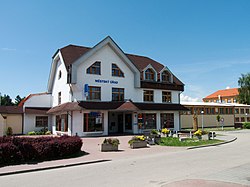Planá nad Lužnicí
Planá nad Lužnicí | |
|---|---|
 Town hall | |
 Flag  Coat of arms | |
 Planá nad Lužnicí Location in the Czech Republic | |
| Coordinates: 49°21′16″N 14°42′5″E / 49.35444°N 14.70139°ECoordinates: 49°21′16″N 14°42′5″E / 49.35444°N 14.70139°E | |
| Country | |
| Region | South Bohemian |
| District | Tábor |
| First mentioned | 1288 |
| Government | |
| • Mayor | Jiří Šimánek |
| Area | |
| • Total | 21.42 km2 (8.27 sq mi) |
| Elevation | 395 m (1,296 ft) |
| Population (2021-01-01)[1] | |
| • Total | 4,305 |
| • Density | 200/km2 (520/sq mi) |
| Time zone | UTC+1 (CET) |
| • Summer (DST) | UTC+2 (CEST) |
| Postal code | 391 11 |
| Website | www |
Planá nad Lužnicí (German: Plan an der Lainsitz) is a town in Tábor District in the South Bohemian Region of the Czech Republic. It has about 4,300 inhabitants.
Administrative parts[]

Village of Lhota Samoty and town part of Strkov are administrative parts of Planá nad Lužnicí.
Geography[]
Planá nad Lužnicí is situated on the river Lužnice about 6 kilometres (4 mi) south of Tábor. There are several fish ponds in the municipal territory.
History[]
Planá nad Lužnicí was first mentioned in a letter of bishop Tobiáš of Bechyně from 1288–1289, when it was part of the Prague episcopacy. From the time Oldřich of Ústí came to power until 1547, Planá was a dependency of the newly established Hussite town of Tábor. Then the town was bought by William of Rosenberg, who had a wooden bridge over the Lužnice river built. The estate was inherited by Peter Vok of Rosenberg, at the end of the 17th century it was taken over by the Sternbergs and later by the House of Lobkowicz.[2]
After 1848, Planá became an independent municipality, which developed also thanks to the construction of the railway line (1869) and timber rafting, which ran here until 1946.[2]
Economy[]
A production plant of MADETA a.s., the largest dairy in the country, is located here since 1969. It is the biggest plant for natural cheeses in the country.[3]
The largest employer with its headquarters in Planá nad Lužnici is SILON s.r.o. The company was originally founded as a polyamide filament yarn producer in 1950. Later it focused on silon production (improved nylon for women's stockings invented by Otto Wichterle). Today it is a producer of polyolefin based performance compounds and polyester fibres.[4]
Transport[]
Planá nad Lužnicí lies on the Prague–České Budějovice railway.
D3 motorway runs alongside the town.
Sights[]

The originally gothic Church of Saint Wenceslaus was rebuilt in 1666. Another reconstruction took place in 1796, when the tower was built. There is a sundial on the wall of the church.[2]
Architecturally valuable is the rectory from 1784 with bossed corners and a covered mansard roof.[2]
Strkov Castle was built in 1903. Today it is privately owned. It has a castle park on the shore of Strkovský pond.[5]
Notable people[]
- František Douda (1908–1990), shot putter, Olympic medalist
Twin towns – sister cities[]
Planá nad Lužnicí is twinned with:[6]
 Gorenja Vas–Poljane, Slovenia
Gorenja Vas–Poljane, Slovenia Hluk, Czech Republic
Hluk, Czech Republic
References[]
- ^ "Population of Municipalities – 1 January 2021". Czech Statistical Office. 2021-04-30.
- ^ Jump up to: a b c d "Historie města" (in Czech). Město Planá nad Lužnicí. Retrieved 2021-09-12.
- ^ "About company". MADETA a.s. Retrieved 2021-09-11.
- ^ "History". SILON s.r.o. Retrieved 2021-09-11.
- ^ "Zámecký park Strkov" (in Czech). Informační systém cestovního ruchu Jihočeského kraje. Retrieved 2021-09-12.
- ^ "Partnerská města" (in Czech). Město Planá nad Lužnicí. Retrieved 2020-08-25.
External links[]
| Wikimedia Commons has media related to Planá nad Lužnicí. |
- Cities and towns in the Czech Republic
- Populated places in Tábor District
